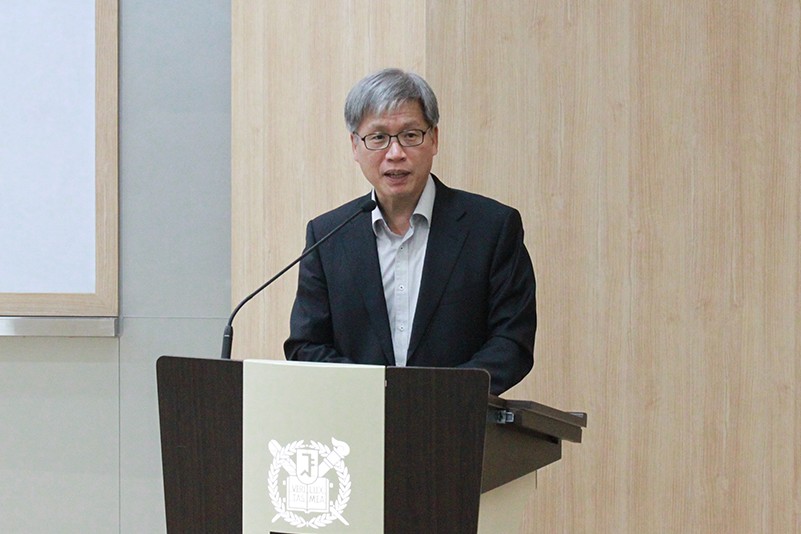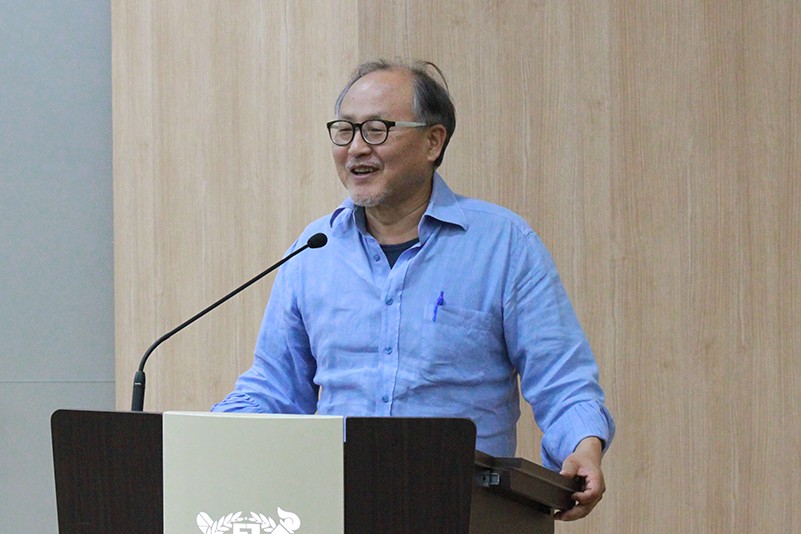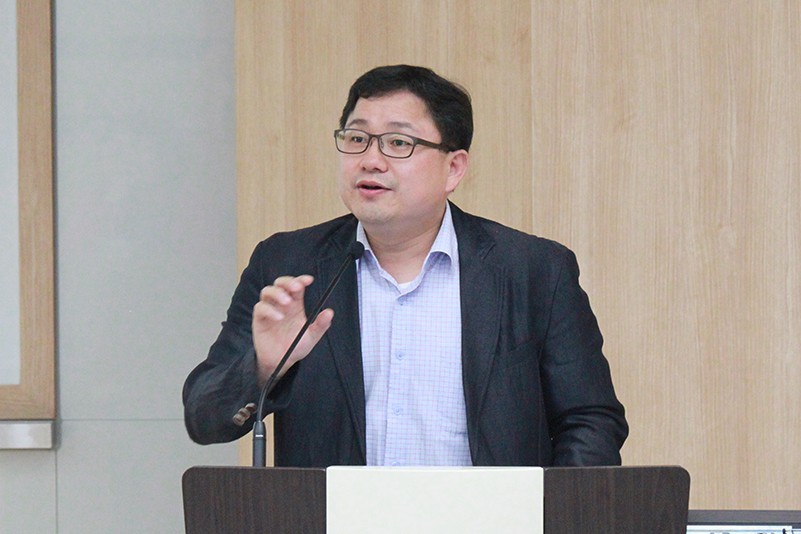[Review] The 2nd Asian Studies of SNUAC
The 2nd Asian Studies of SNUAC
On June 2nd, 2015, the 2nd Joint Academic Conference of SNUAC “Asian Studies of SNUAC” took place at the Youngone Hall. The conference provides a ground for SNUAC’s research centers and thematic research programs to present and share research outcomes. This was the second time it was held, following the previous one held last November.

This year’s conference provided an opportunity to reaffirm SNUAC’s initiative and objectives. The members of the center who are solidifying and leading SNUAC gathered around in a friendly atmosphere and shared ideas on the center’s academic improvement, concerns, and results, seeking for SNUAC’s way forward.
During the conference, presentations were delivered by five thematic research programs (Popular Culture, Environmental Cooperation, U.S.-China Relations, Civil Society, Asia-Global Economic Order), two centers (Central Asia Center, Southeast Asia Center), and the SSK Research Group. In addition, other research centers, programs, and research groups introduced their major activities.
The conference began with an opening speech by the Director of SNUAC, Kang Myung-koo, who stated, “This conference was organized to have all of SNUAC’s members, including research centers, programs, and research groups, gather around and share past activities. The very purpose of this conference is internal sharing rather than inviting other guests.” He added, “To evaluate SNUAC, which has marked its fifth anniversary since it has been established, its international score is 70 and its domestic score 90, which makes up an average of 80. I hope that this score improves to 90 and SNUAC becomes a true global player. I expect that this conference can become an opportunity to assess and look back on whether the center has been conducting significant research and making widely recognized achievements.”

The first session of the conference was prepared by thematic research programs and one SSK research group. The first presentation was given by Director Kang Myung-koo, and Professor Kim, Hong-Jung(Deparment of Sociology) from the Popular Culture program.
First, under the title, ‘Those who dream and those who cannot dream’, Director Kang Myung-koo presented an empirical study on the life of Korean and Japanese youths. Director Kang looked into the reality of life based on specific statistical data on the economic level, education, jobs, family formation, and so on. In addition, he introduced how youths cope with the difficulties they face, through various case studies. The presentation looked through statistics up to date and suggested analyzing the extent that Korean and Japanese youths ‘dream’ and its relationship with other factors, through advanced statistical analysis and qualitative research.

Professor Kim presented under the title, ‘A case study on Korean and American “Control” chaos’, which is about the symbolic battle that occurred in the Korean hiphop community. This study explains the features of the Korean “Control” diss song battle which was inspired by that of the U.S.
The diss battle in the U.S. is a kind of ceremony. It is a public behavior that shares common characteristics with social performances, revealing the authenticity in hiphop. On the other hand, the battle in Korea was full of personal insult, comments on personal life, and personal slander, which failed to be a symbolic violence and ended up as an exchange of personal insult. This is a case that shows that the Korean hiphop community has not yet established a clear ‘hiphop authenticity’ unlike the U.S. which pursues a hiphop feature established on a relatively stable code.

From the Environmental Cooperation program (Director: Professor Park, Soo-Jin), Professor Park presented on the topics, ‘Research on Asia’s land devastation and social ecological system’ and ‘Feng-shui research as Asia’s common value’, respectively.
First, Professor Park introduced the Environmental Cooperation program. The objective of the program is to develop a new Asian perspective on the environment that can overcome spacial differences and create a decision-making system for sustainable land use. The program is conducting case studies under the ELD (Economics of Land Degradation) international research and cooperation network that aims to grasp the influence of changes in land use.
In specific, it is conducting field studies or indirectly supporting them by selecting five social ecological locations: South China (temperate region, mountain area), Mongolia (dry region), the Korean peninsula (temperate region), North Korea (devastated region), and the Mekong (tropical region). Meanwhile, Professor Choi Won Seok(school of business) gave a presentation on the contemporary rediscovery of the ‘feng shui’ as an East Asian environmental ideology, which drew attention.

The Korea-China Relations program(Director: Professor Jae Ho Chung) delivered a presentation on the topic, ‘The implication of the UK-US power transition on the 21st century US-China relations.’ While there has been active debate about the possibility of a power transition between the US. and China, Professor Chung, Jae Ho looked into the features of the UK-US power transition process and introduced a research that seeks for the possibility of a peaceful US-China power transition.
The factors that he went through included geographical distance, features of finance, economic interdependence, the existence of a rational leadership, and a smooth transition through the World War. According to these factors, compared to the case of the UK and the U.S. which went through a relatively smooth transition, it was carefully predicted that factors such as leadership with difference backgrounds and a relatively close geographical distance will raise the possibility of a pessimistic scenario.

From the SSK East Asia Research Group (Director: Professor Park, Bae-Gyoon), Professor Park gave an introduction under the title, ‘East Asia’s developmental urbanization and the urban crisis.’ First, he pointed out the importance of reforming the explanatory framework in a ‘multi-scale’ perspective, considering the level of ‘city’ when viewing East Asia. As a result, the research group has been examining East Asian cities’ features, focusing on the compressibility, exceptionality, and the risk that the ‘Cold-war developmental urbanization’ reflects.
Next, SNUAC’s research fellow Kim, Eunhye delivered a presentation on the specific research results and case analysis results on the topic, ‘East Asia developmental state’s nuclear-dependent urbanization and the political economy of riskscape. In particular, through the case of Japan’s ‘nuclear complex’, she showed an aspect of East Asia developmental state’s dangerous city which is the world’s largest nuclear development concentrated zone.

From the Civil Society program(Director: Professor Lim Hyun-Chin) SNUAC’s research fellow Kong Suk-ki presented on the topic, ‘Topographic map of the Korean civil society.’ First, he summarized the analysis results based on the basic statistics compiled by a civil society program which transformed the 2012 civil group comprehensive material to a DB in 2013.
The conference was followed by the second session in which presentations were given by two regional research centers and one research program. First, from the Central Asia Center (Director: Professor Shin, Beom-shik), Professor Shin presented on ‘the rise of China and central Asia’ s response.’
Professor Shin pointed out that to understand Eurasian countries’ dynamics, the rise of China and an active advance to Central Asia are the major issues to focus, and discussed on specific activities of China and the response of Central Asian countries. He stated that because China has a non-intervention principle on Central Asian countries’ domestic politics, China is viewed as an attractive superpower. He continued to discuss on the reality of China’s expanding influence, such as the growing trade volume.

In addition, Seoungjo Yang introduced the research on ‘the establishment of series and DB of Central Asia Korean’s traditional daily culture’ which is an infrastructural research project, and talked about its background; the studies on Kazakhstan Korean and the features of their traditional daily culture.

From the Southeast Asia Center (Director: Professor Oh, Myung-seok), Research Fellow Jung, Bub-mo delivered a presentation on‘Malaysia’s consumption trend.’ Malaysia has a large consumption expenditure compared to its population or economic scale, and stands out as the leader of the ASEAN market in which the middle-class market is growing. The presenter discussed the features of Malaysia’s consumers and culture, and gave emphasis on the need to understand Halal-related laws and institutions.

Lastly, from the Asia-Global Economic Order program (Director: Professor Park Ji-hyung), research fellow Kim Min-jung presented on the ‘technical standard and international trade order’. As a research on ‘Technical Barriers on Trade(TBT)’ which became one of the issues of non-tariff trade barriers, she discussed the outcomes of analyzing the how the concept of ‘standard’ has developed in the WTO’s TBT Agreement.
The ‘standard’ was initially in the form of a compulsory-voluntary standard. However, as it reached the WTO era through the process of technical specification, it divided into a technical standard as technical regulation compulsory requirement and a standard as the voluntary requirement. However, the distinction between compulsory and voluntary performances are becoming too ambiguous for its importance.


In the last session, other regional research centers and programs introduced their 2015 major research activities. Afterwards, all participants continued to have mutual exchange and discussion over dinner.
This conference was a fruitful opportunity for various members to share and understand the studies that are being carried out by SNUAC. The researchers who participated in this conference said, “It seems that the two joint academic conferences have led us to be aware that we are co-workers under one umbrella.” It is expected that “Asian Studies of SNUAC” will become a representative academic conference which notifies SNUAC’s research results both internally and externally, in addition to promoting mutual communication within the research center.
Written by Sungmin Lee, Yungdong Choi (PR Assistant)
